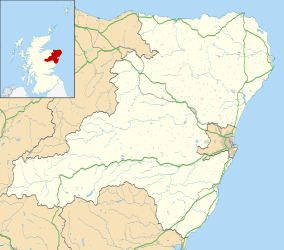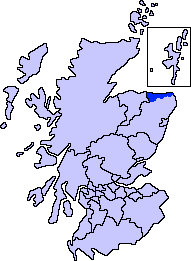Inverallochy and Cairnbulg
The villages of Inverallochy (Scottish Gaelic: Inbhir Aileachaidh) and Cairnbulg (from the Gaelic càrn builg meaning 'gap cairn'[3]) lie some four miles east of Fraserburgh, in North East Scotland.
Inverallochy and Cairnbulg
| |
|---|---|
 Inverallochy and Cairnbulg Location within Aberdeenshire | |
| Population | 1,197 [1] (2001 census) est. 1,380[2] (2006) |
| OS grid reference | NK041650 |
| Council area | |
| Lieutenancy area | |
| Country | Scotland |
| Sovereign state | United Kingdom |
| Post town | FRASERBURGH |
| Postcode district | AB43 |
| Dialling code | 013465 |
| Police | Scotland |
| Fire | Scottish |
| Ambulance | Scottish |
| UK Parliament | |
| Scottish Parliament | |
Cairnbulg Castle, one of The Nine Castles of Knuckle, originally dated to the 13th century and parts of the current construction are believed to date to an earlier period[4] but whereas the land of Inverallochy was granted by Earl Alexander to Jordan Comyn in 1277, there is no indication that the now-ruined Inverallochy Castle was built at such an early date.[5] Cairnbulg Castle was a stronghold of the Comyns, but was given by Robert the Bruce to the Earls of Ross in 1316 following the Harrying of Buchan, then passed to the Frasers from 1375 until 1666. The current construction is a late 19th-century re-build following a century of abandonment and dereliction.

Well-established fishing communities were in place in the area by the early 16th century, but after an epidemic of cholera in the 1860s wiped out the "collections of huts next to which fishing boats were dragged out of reach of the tide", planned fishing settlements were recreated at Inverallochy and the twinned village Cairnbulg. As a result of this planning, within 20 years over 200 boats were based here, although in recent years this has dwindled to almost zero as larger, commercial operations became focused on the nearby ports of Fraserburgh and Peterhead.
Cairnbulg railway station was opened on 1 July 1903. It was originally named Inverallochy, but was renamed on 1 September, two months after it opened. The station closed in 1965.[6] Philorth Bridge Halt was located near the Water of Philorth at the entrance to Cairnbulg Castle.
Owing to the close proximity of the villages to one another, the name Invercairn has in recent years become used on a local basis to represent both.
Attractions
Maggie's Hoosie is a preserved 19th century fishwife's cottage. Cairnbulg harbour, built in the 1920s as a single pier, was developed in the early 1980s using WW2 tank traps to create an enclosed harbour basin.
Inverallochy School was established in 1841 as a 36 × 20 feet building that seated 88 scholars. Increased attendance demanded further funding in 1866 to seat 130 scholars and 240 in 1872. It finally re-opened in 1965 after a substantial extension to include eight new classrooms, a general purpose room, a school meal scullery, an assembly hall–gymnasium and an art room. The eight old classrooms were turned into homecraft rooms with housewifery area, science rooms and library.
References
- "Comparative Population Profile: Inverallochy and Cairnbulg Locality". Scotland's Census Results Online. 29 April 2001. Archived from the original on 19 May 2011. Retrieved 1 September 2008.
- "Archived copy". Archived from the original on 16 September 2009. Retrieved 31 January 2010.CS1 maint: archived copy as title (link)
- History of Gaelic Archived 11 September 2007 at the Wayback Machine bord-na-gaidhlig.org.uk, accessed 10 August 2009
- W. D. Simpson, Cairnbulg Castle, Aberdeenshire, May 1949. (online at http://ads.ahds.ac.uk/catalogue/adsdata/PSAS_2002/pdf/vol_083/83_032_044.pdf)
- D. Macgibbon & T. Ross, The Castellated and Domestic Architecture of Scotland from the 12th to the 18th centuries, Edinburgh, 1887-92.
- Buchan, Jim. Bygone Cairnbulg, Inverallochy & St Combs, Stenlake Publishing, 2014. ISBN 9781840336665
External links
| Wikimedia Commons has media related to Inverallochy and Cairnbulg. |

